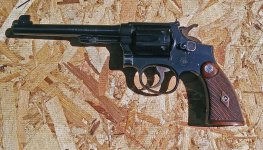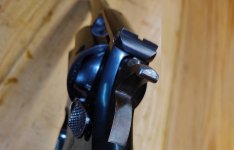Against all expectation, a K-32 First Model has at long last taken up residence in my safe: 675702, shipped May 24, 1939 to the Old Dawley Gun Store in Montpelier, Vermont. The order was placed on behalf of the Washington County Sheriff's Department, though an individual is not named in known documents. From state and local records we know that the Washington County Sheriff that year was Henry Curtis Lawson (1880-1959), who held the position from 1927 to 1953. It's probably a safe bet that he authorized the order.



The revolver has been refinished, but with some skill. It appears to have been done elsewhere than the factory, as there is no star by the serial number or return date on the grip frame. On the other hand, this could be a factory refinish if the work was done in the 1960s or early '70s at a time when the factory was no longer marking guns returned for such service. The ejector star is completely blued, as is the beveled front face on the ejector rod knob. Rollmarks are still completely legible, though a little softer than the original markings would have been. The expected patent office marking is absent from both hammer and trigger, which probably indicates replacement. Hammer and trigger both retain what I believe to be the original case hardening. The excellent prewar magnas with patent-stamped interior medallion anchors are probably not original to the revolver, but are age-appropriate. The stocks are unnumbered and protrude slightly beyond the edges of the forestrap. I was told that the original front sight on the gun was a standard Patridge blade, and that the current McGivern gold bead is a replacement. The letter is silent on this point. As a big fan of the McGivern beads, I am not about to change it. I need to rephotograph the front sight, as the image I hoped to include at this time had upload problems.
This revolver first caught my eye in an on-line auction in 2011. I captured its serial number for inclusion in a data base of these rare models. This revolver was not at that time found in the roster of known specimens, and I am now walking around in amazement at the way circumstances managed to put both of us in the same room all these years later.
S&W production records for this model attest to 96 units produced in 1939 and 1940. A few more are known at present from special orders and conversions in the immediately preceding years. There is a possibility that a few more specimens exist that are at this time below the horizon.



The revolver has been refinished, but with some skill. It appears to have been done elsewhere than the factory, as there is no star by the serial number or return date on the grip frame. On the other hand, this could be a factory refinish if the work was done in the 1960s or early '70s at a time when the factory was no longer marking guns returned for such service. The ejector star is completely blued, as is the beveled front face on the ejector rod knob. Rollmarks are still completely legible, though a little softer than the original markings would have been. The expected patent office marking is absent from both hammer and trigger, which probably indicates replacement. Hammer and trigger both retain what I believe to be the original case hardening. The excellent prewar magnas with patent-stamped interior medallion anchors are probably not original to the revolver, but are age-appropriate. The stocks are unnumbered and protrude slightly beyond the edges of the forestrap. I was told that the original front sight on the gun was a standard Patridge blade, and that the current McGivern gold bead is a replacement. The letter is silent on this point. As a big fan of the McGivern beads, I am not about to change it. I need to rephotograph the front sight, as the image I hoped to include at this time had upload problems.
This revolver first caught my eye in an on-line auction in 2011. I captured its serial number for inclusion in a data base of these rare models. This revolver was not at that time found in the roster of known specimens, and I am now walking around in amazement at the way circumstances managed to put both of us in the same room all these years later.
S&W production records for this model attest to 96 units produced in 1939 and 1940. A few more are known at present from special orders and conversions in the immediately preceding years. There is a possibility that a few more specimens exist that are at this time below the horizon.
Last edited:


